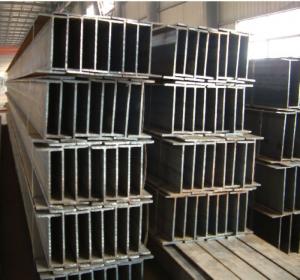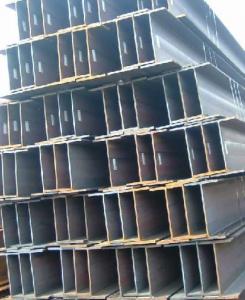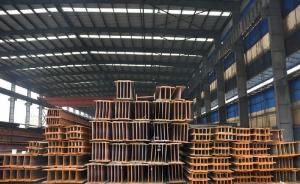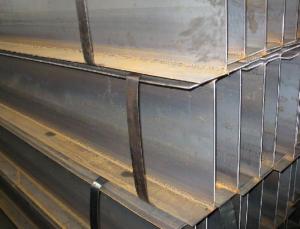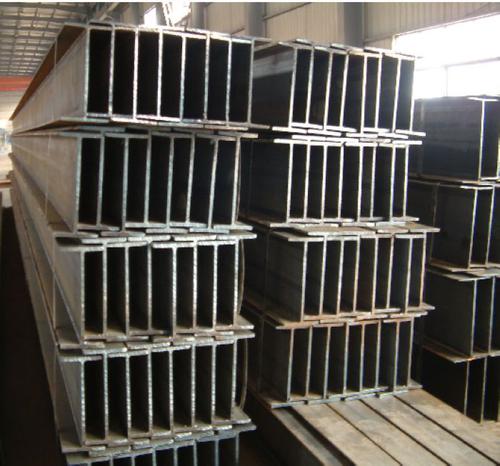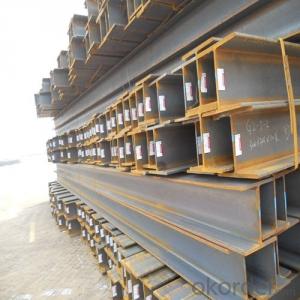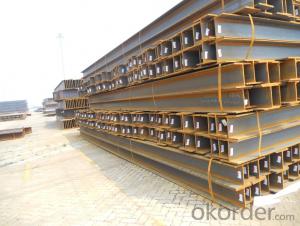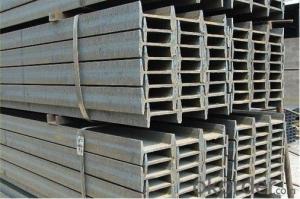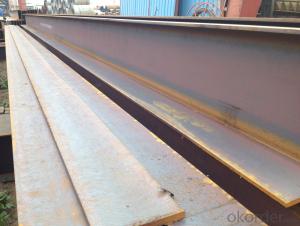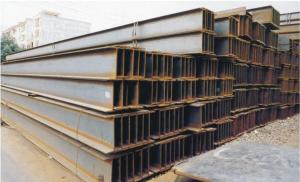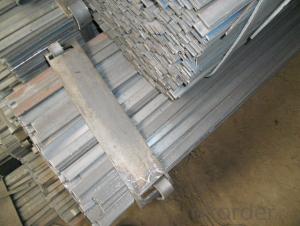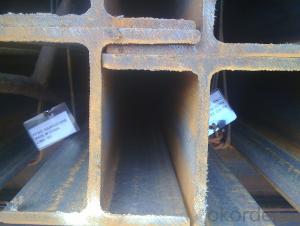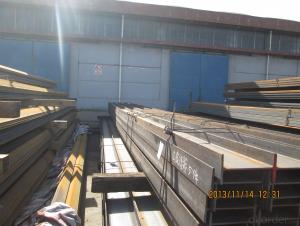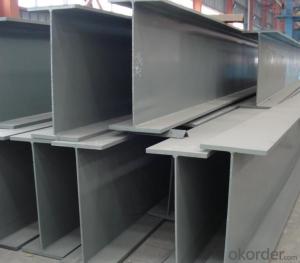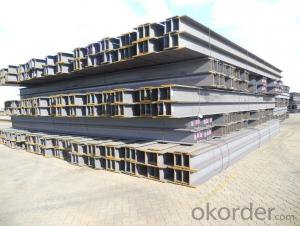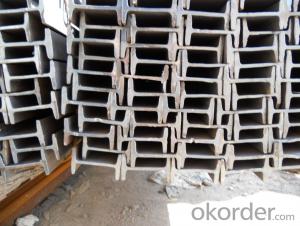H Beam
- Loading Port:
- China Main Port
- Payment Terms:
- TT OR LC
- Min Order Qty:
- -
- Supply Capability:
- 10000 m.t./month
OKorder Service Pledge
OKorder Financial Service
You Might Also Like
Product Description:
Specifications of Hot Rolled Structural Steel H Beam
1. Standard: GB700-88, Q235B2.
2. Grade: Q235, SS400 or Equivalent
3. Length: 6m,10m, 12m as following table
4. Invoicing on theoretical weight or actual weight as customer request
5.Payment: TT or L/C
6. Sizes:
SIZE(mm) | DIMENSION(kg/m) |
100*100 | 16.9 |
125*125 | 23.6 |
150*75 | 14 |
150*150 | 31.1 |
148*100 | 20.7 |
198*99 | 17.8 |
200*100 | 20.9 |
248*124 | 25.1 |
250*125 | 29 |
Usage & Applications of Hot Rolled Structural Steel H Beam
Commercial building structure ;Pre-engineered buildings; Machinery support structure; Prefabricated structure; Medium scale bridges; Ship-building structure. etc.
Packaging & Delivery of Hot Rolled Structural Steel H Beam
1. Packing: it is nude packed in bundles by steel wire rod
2. Bundle weight: not more than 3.5MT for bulk vessel; less than 3 MT for container load
3. Marks:
Color marking: There will be color marking on both end of the bundle for the cargo delivered by bulk vessel. That makes it easily to distinguish at the destination port.
Tag mark: there will be tag mark tied up on the bundles. The information usually including supplier logo and name, product name, made in China, shipping marks and other information request by the customer.
If loading by container the marking is not needed, but we will prepare it as customer request.
4. Transportation: the goods are delivered by truck from mill to loading port, the maximum quantity can be loaded is around 40MTs by each truck. If the order quantity cannot reach the full truck loaded, the transportation cost per ton will be little higher than full load.
5. Delivered by container or bulk vessel
Production flow of Hot Rolled Structural Steel H Beam
Material prepare (billet) —heat up—rough rolling—precision rolling—cooling—packing—storage and transportation
- Q: How do steel H-beams contribute to the overall sound insulation of a building?
- Steel H-beams do not directly contribute to the overall sound insulation of a building. Sound insulation is mainly achieved by using materials with high sound transmission class (STC) ratings, such as acoustic insulation, double-glazed windows, and soundproof doors. Steel H-beams, being structural components, primarily provide support and stability to the building structure rather than contributing to sound insulation.
- Q: Can steel H-beams be used in museum and art gallery construction?
- Museum and art gallery construction can incorporate steel H-beams for a variety of purposes. These beams possess strength, durability, and versatility, making them a popular choice in construction. They provide structural support and stability, making them suitable for large and intricate architectural designs found in museums and art galleries. Steel H-beams have multiple functions in museum and art gallery construction. They can serve as load-bearing elements, ensuring the building's stability and safety. Additionally, these beams can create spacious interiors and high ceilings, accommodating flexible exhibition layouts and the display of large artworks. Moreover, steel H-beams can contribute to the aesthetic appeal of the museum or art gallery. They can be exposed and integrated into the interior design, aligning with the artistic vision and enhancing the overall atmosphere and ambiance of the space. Furthermore, steel H-beams offer benefits in terms of cost-effectiveness and construction efficiency. They are lightweight, facilitating easier transportation and installation compared to other materials. Furthermore, steel is a recyclable material, aligning with sustainable construction practices. However, it is crucial to consider specific design requirements, load-bearing capacities, and the architectural vision when deciding to incorporate steel H-beams in museum and art gallery construction. Consulting with structural engineers and architects specialized in museum and art gallery construction is necessary to ensure the proper utilization of steel H-beams and the achievement of desired artistic and functional outcomes.
- Q: Can steel H-beams be used for supporting agricultural structures?
- Yes, steel H-beams can be used for supporting agricultural structures. Steel H-beams are known for their strength and durability, making them suitable for various applications, including agricultural structures. Their high load-bearing capacity allows them to support heavy loads and withstand various environmental conditions. Whether it is for constructing barns, greenhouses, storage buildings, or other agricultural structures, steel H-beams provide a reliable and long-lasting support system. Additionally, steel is resistant to pests, rot, and fire, making it an ideal choice for agricultural applications where these factors are important considerations.
- Q: How do steel H-beams perform in sports arena construction?
- Sports arenas commonly use steel H-beams for their outstanding structural performance. These beams offer superior strength and load-bearing capabilities, making them perfect for supporting the heavy loads and stresses that sports arenas encounter. The design of steel H-beams promotes even weight distribution, enabling them to evenly distribute loads from the roof, lighting systems, and other equipment in the arena. This ensures the building's structural integrity and prevents any potential failures or collapses. Furthermore, steel H-beams possess a high resistance to bending and twisting forces, making them suitable for withstanding the dynamic loads generated by sporting events like basketball games or concerts. They also exhibit excellent fire resistance, which is crucial for ensuring the safety of both spectators and athletes. Moreover, steel H-beams are versatile and can be easily customized to meet the specific design requirements of sports arenas. Architects and engineers can fabricate them into various lengths, sizes, and shapes, allowing for the creation of innovative and aesthetically pleasing structures. Additionally, steel H-beams have a long lifespan and require minimal maintenance, making them a cost-effective choice for sports arena construction. They are also recyclable, aligning with sustainable construction practices. In conclusion, steel H-beams play a vital role in sports arena construction due to their exceptional strength, load-bearing capabilities, resistance to bending and twisting forces, fire resistance, versatility, and long lifespan. These beams ensure the safety and structural integrity of sports arenas, providing a solid foundation for hosting sporting events and other activities.
- Q: Can Steel H-Beams be used in historical or heritage restoration projects?
- Yes, Steel H-Beams can be used in historical or heritage restoration projects. Steel H-Beams are versatile and strong structural elements that can provide support and stability to buildings, especially when restoring or reinforcing historic structures. They can be used to replace or reinforce deteriorated or damaged wooden beams, offering increased structural integrity while preserving the historical character of the building. Additionally, Steel H-Beams can be designed to match the original architectural aesthetics, ensuring a seamless integration into the existing structure. However, it is important to consult with preservation specialists and adhere to local heritage regulations to ensure that the use of Steel H-Beams aligns with the principles of historical preservation.
- Q: How do steel H-beams provide structural support?
- Structural support is provided by steel H-beams through the utilization of their distinct shape and material properties. The beam's "H" shape allows for the even distribution of weight and forces, resulting in a load-bearing capacity that is both robust and efficient. To support and bear the weight placed upon them, the top and bottom flanges of the H-beam offer a generous surface area. These flanges are connected by a vertical web, which enhances rigidity and aids in resisting bending and twisting forces. The selection of steel as the primary material for H-beams contributes to their strength and durability. Steel possesses high tensile strength, enabling it to withstand significant force without breaking or deforming. Consequently, steel H-beams are a superior choice for supporting heavy loads and ensuring structural stability in various applications, including bridges, buildings, and infrastructure projects. Furthermore, steel H-beams can be easily fabricated and joined together, allowing for the construction of lengthy spans and flexible designs. They can be welded or bolted together, forming larger structures and providing continuous support throughout the entirety of a building or bridge. In summary, steel H-beams efficiently distribute weight and forces, capitalizing on their unique shape and material properties to offer structural support. They possess strength, durability, and flexibility, making them an excellent option for a wide range of construction projects.
- Q: Can steel H-beams be used in cold storage facilities?
- Yes, steel H-beams can be used in cold storage facilities. Steel is a highly durable and strong material that can withstand low temperatures without losing its structural integrity. H-beams provide excellent load-bearing capabilities, making them suitable for supporting heavy loads and maintaining the stability of the facility's structure in cold storage environments.
- Q: What is the length of the butt joint of H steel? What is the minimum requirement?
- No, just on the basis of the docking process.
- Q: How do steel H-beams perform in high-wind areas?
- Due to their inherent strength and rigidity, steel H-beams are highly effective in high-wind areas. The structural design of H-beams enables them to withstand bending and twisting forces, making them ideal for withstanding the intense loads produced by strong winds. These beams have a considerable load-bearing capacity and can effectively distribute the wind load along their length, which helps prevent structural failure. The wide flanges and thick web of the H-beam shape provide additional stability against wind forces. The flanges function as wings, creating a larger surface area that reduces the wind pressure on the beam. This design feature minimizes the risk of the beam being pushed or bent by the wind. Moreover, steel is a robust and durable material that exhibits exceptional resistance to weathering and corrosion. This quality makes steel H-beams particularly well-suited for high-wind areas, where exposure to harsh weather conditions, such as saltwater or heavy rain, is common. To ensure optimal performance in high-wind areas, it is crucial to consider the specific design requirements and wind loads that a structure may encounter. Engineers employ various methods, such as wind tunnel testing and computational fluid dynamics, to accurately predict the wind forces and select appropriate H-beam sizes and configurations. Additionally, proper installation and anchoring techniques are vital to ensure the H-beams remain securely in place during severe weather events. In conclusion, steel H-beams are specifically designed to excel in high-wind areas. Their structural properties, including strength, rigidity, and resistance to bending, make them highly dependable for withstanding the forces generated by strong winds. When engineered and installed correctly, steel H-beams offer a safe and durable solution for structures in wind-prone regions.
- Q: What's the difference between I-beam and H steel?
- H steel is a kind of economical section steel with better mechanical properties than I-beam. Its shape is named after its English letter "H". The flange of hot rolled H steel is wider than that of I-beam, big lateral rigidity and strong bending resistance. Under the same specifications, H steel is lighter than i-beam.
Send your message to us
H Beam
- Loading Port:
- China Main Port
- Payment Terms:
- TT OR LC
- Min Order Qty:
- -
- Supply Capability:
- 10000 m.t./month
OKorder Service Pledge
OKorder Financial Service
Similar products
Hot products
Hot Searches
Related keywords
